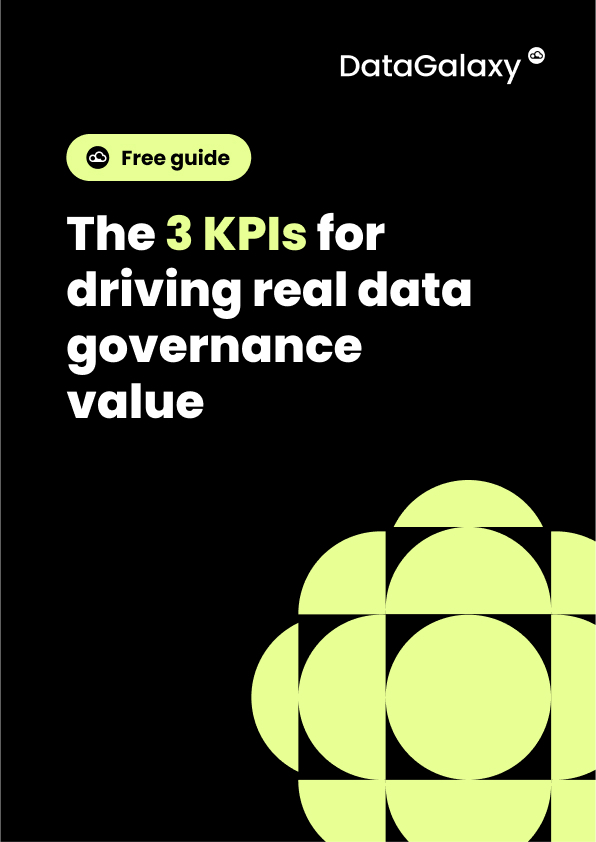
Top 3 data management strategies for working with AI tools (2026)
AI is changing data management. Have you adjusted your strategy to keep up?
To maximize the efficacy of AI-powered tools, you need a data management strategy that focuses on more than pipelines and storage. It needs to position AI readiness and automation at the center of your design.
What is a data management strategy?
Data management strategies define how information is collected, stored, governed, and secured. Traditionally, the primary focus of data management was on handling volume, variety, and velocity.
However, AI is demanding more. Your data management strategy is now the foundation for AI-driven processes.
Without a deliberate focus on AI readiness, your framework won’t prevent bias, misinterpreted patterns, or security risks, leaving AI models and platforms vulnerable to failure.
Let’s break down the key components of a data management strategy, redefined for AI.

The 3 KPIs for driving real data governance value
KPIs only matter if you track them.
Move from governance in theory to governance that delivers.
Download the free guideKey components of an AI-ready data management strategy
An AI-ready data management strategy aligns priorities with the new realities of AI-driven ecosystems:
AI-first data governance
Establishing ownership, traceability, and policy enforcement so AI models train on consistent, well-classified data without duplication or drift
AI-optimized data quality
Curating structured, bias-free, high-integrity datasets to prevent AI from reinforcing outdated patterns or unreliable insights
Security & privacy for AI data
Protecting AI training data from unauthorized access, poisoning, and other threats that compromise integrity
AI-driven data automation
Using AI itself to organize data, track lineage, and detect anomalies
These elements provide the clarity, structure, and data quality required to maximize the outcomes of AI models and processes.
Now, let’s take a look at the strategies needed to support this framework.
Top data management strategies for AI-driven organizations
Traditional data management strategies weren’t built for AI. They focus on storage and access, but AI requires governance, security, and automation at every stage of its development.
Without these, AI models inherit inconsistencies, amplify biases, and expose organizations to compliance risks.
The following three strategies are key to building an AI-ready foundation.
1. Embed data governance into AI workflows
Eliminate manual tracking and enforcement of data governance policies. Integrate governance controls directly into AI workflows.
Assign responsibility for AI training data
This injects accountability for data accuracy, classification, and compliance before it enters AI pipelines
Embed automated governance mechanisms
to validate data against policies in real-time as it is ingested, transformed, and used by AI
Use AI-driven policy enforcement
such as access controls and lineage tracking, to maintain regulatory compliance
This strategy shifts governance from reactive oversight to proactive enforcement.
2. Secure AI data & enforce privacy controls
Instead of reacting to security threats and compliance risks, build security and privacy into AI data pipelines from the start to prevent breaches, unauthorized model training, and regulatory violations.
Control access at the source
by enforcing role-based permissions that limit AI training data to authorized users and applications
Embed real-time anomaly detection
to flag suspicious access patterns, data drift, or potential poisoning attempts before they compromise AI models
Automate compliance enforcement
by integrating encryption, anonymization, and policy-based access controls directly into AI workflows
Moving security and privacy controls directly into AI data pipelines ensures that AI models are trained on protected, policy-compliant data.
CDO Masterclass: Upgrade your data leadership in just 3 days
Join DataGalaxy’s CDO Masterclass to gain actionable strategies, learn from global leaders like Airbus and LVMH, and earn an industry-recognized certification.
Save your seat!3. Optimize data selection & automate preprocessing
Prioritize data selection and automate preprocessing to improve accuracy and efficiency for AI processes.
Curate training datasets with AI-assisted sampling to balance real-time and historical data
This keeps AI models adaptable and context-aware
Automate preprocessing tasks
like data cleaning, deduplication, and feature engineering to remove noise and maintain data integrity
Embed continuous bias detection
to identify and mitigate skewed datasets before they distort AI-driven insights
Embedding data selection and preprocessing into AI workflows strengthens AI-driven outcomes and reduces model drift.
How DataGalaxy powers AI-driven data management
The above strategies—governance integration, security enforcement, and optimized data selection—aren’t just theoretical.
DataGalaxy applies these principles with AI-powered tools that automate governance, streamline security, and refine data quality at scale.
- Automated governance embeds real-time access policies and compliance enforcement directly into AI workflows.
- Data lineage tracking provides end-to-end visibility into how data flows, transforms, and impacts AI models.
- Data processing tools visualize and document all data transformations, ensuring AI models work with structured, properly processed data.
By embedding AI into data management, DataGalaxy helps organizations enhance governance, strengthen security, and ensure AI operates on a reliable, compliant, and optimized data foundation.
AI delivers results only when built on a strong data foundation.
DataGalaxy provides all the AI-powered governance, security, and automation you need to build a resilient, AI-ready data management strategy.
FAQ
- What is data lineage?
-
Data lineage traces data’s journey—its origin, movement, and transformations—across systems. It helps track errors, ensure accuracy, and support compliance by providing transparency. This boosts trust, speeds up troubleshooting, and strengthens governance.
- What is data governance?
-
Data governance ensures data is accurate, secure, and responsibly used by defining rules, roles, and processes. It includes setting policies, assigning ownership, and establishing standards for managing data throughout its lifecycle.
- What is AI governance?
-
AI governance is the framework of policies, practices, and regulations that guide the responsible development and use of artificial intelligence. It ensures ethical compliance, data transparency, risk management, and accountability—critical for organizations seeking to scale AI securely and align with evolving regulatory standards.
- Why is AI governance important?
-
AI governance is crucial because it ensures that artificial intelligence systems are developed and deployed responsibly. Without proper governance, AI can perpetuate biases, compromise data privacy, and make opaque decisions that affect individuals and society. Effective AI governance establishes frameworks and policies that promote ethical use, transparency, and accountability in AI applications.
- What is a data product?
-
A data product is a curated, reusable data asset designed to deliver specific value. It encompasses not just raw data, but also the necessary metadata, documentation, quality controls, and interfaces that make it usable and trustworthy. Data products are typically aligned with business objectives and are managed with a product-oriented mindset, ensuring they meet the needs of their consumers effectively.
At a glance
- AI is reshaping data management, requiring strategies that prioritize governance, quality, security, and automation to ensure trustworthy and effective AI outcomes.
- Embedding governance, privacy, and preprocessing directly into AI workflows creates proactive, compliant, and bias-resistant data pipelines.
- DataGalaxy enables this shift with AI-powered tools that automate governance, secure data, and optimize quality, building a resilient foundation for AI-driven organizations.

